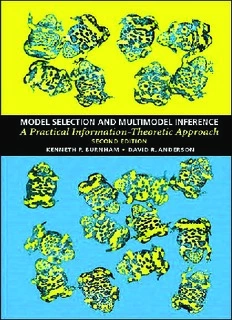Table Of ContentModel Selection and Multimodel Inference
SecondEdition
Springer
NewYork
Berlin
Heidelberg
Barcelona
HongKong
London
Milan
Paris
Singapore
Tokyo
Kenneth P. Burnham David R. Anderson
Model Selection and
Multimodel Inference
A Practical Information-Theoretic Approach
Second Edition
With31Illustrations
1 3
KennethP.Burnham
DavidR.Anderson
ColoradoCooperativeFish
andWildlifeResearchUnit
ColoradoStateUniversity
FortCollins,CO80523-1484
USA
CoverIllustration:Thecoverwasassembledfromphotosoftheyellow-belliedtoad(Bombinavarie-
gata)takenbyJonasBarandumaspartofhisPh.D.programattheUniversityofZurich.Thesetoads
haveindividuallyidentifiablepatternsontheirabdomenfromafewweeksfollowingmetamorphosis
thatremainunchangeduntildeath.Twopairsareduplicates—butwhichtwo?
CoverphotographsbyDr.JonasBarandum,St.Gallen,Switzerland.CoverdesignbyKentonAllred.
LibraryofCongressCataloging-in-PublicationData
Burnham,KennethP.
Modelselectionandmultimodelinference:apracticalinformation-theoreticapproach
/KennethP.Burnham,DavidR.Anderson.—2nded.
p. cm.
Rev.ed.of:Modelselectionandinference.©1998.
Includesbibliographicalreferences(p. ).
ISBN0-387-95364-7(alk.paper)
1.Biology—Mathematicalmodels. 2.Mathematicalstatistics. I.Burnham,KennethP.
Modelselectionandinference. II.Title.
QH323.5 B87 2002
570(cid:1).1(cid:1)51—dc21 2001057677
ISBN0-387-95364-7 Printedonacid-freepaper.
©2002,1998Springer-VerlagNewYork,Inc.
Allrightsreserved.Thisworkmaynotbetranslatedorcopiedinwholeorinpartwithoutthewritten
permissionofthepublisher(Springer-VerlagNewYork,Inc.,175FifthAvenue,NewYork,NY10010,
USA),exceptforbriefexcerptsinconnectionwithreviewsorscholarlyanalysis.Useinconnection
withanyformofinformationstorageandretrieval,electronicadaptation,computersoftware,orby
similarordissimilarmethodologynowknownorhereafterdevelopedisforbidden.
Theuseinthispublicationoftradenames,trademarks,servicemarks,andsimilarterms,evenifthey
arenotidentifiedassuch,isnottobetakenasanexpressionofopinionastowhetherornottheyare
subjecttoproprietaryrights.
PrintedintheUnitedStatesofAmerica.
9 8 7 6 5 4 3 2 SPIN10853081
www.springer-ny.com
Springer-Verlag NewYork Berlin Heidelberg
AmemberofBertelsmannSpringerScience+BusinessMediaGmbH
Tomymotherandfather,LucilleR.(deceased)andJ.CalvinBurnham
(deceased),andmysonanddaughter,ShawnP.andSallyA.Burnham
Tomyparents,CharlesR.(deceased)andLetaM.Anderson;mywife,
DaleneF.Anderson;andmydaughters,TamaraE.and
AdrienneM.Anderson
This page intentionally left blank
Preface
We wrote this book to introduce graduate students and research workers in
variousscientificdisciplinestotheuseofinformation-theoreticapproachesin
theanalysisofempiricaldata.Thesemethodsallowthedata-basedselection
of a “best” model and a ranking and weighting of the remaining models in
a pre-defined set. Traditional statistical inference can then be based on this
selected best model. However, we now emphasize that information-theoretic
approachesallowformalinferencetobebasedonmorethanonemodel(mul-
timodel inference). Such procedures lead to more robust inferences in many
cases,andweadvocatetheseapproachesthroughoutthebook.
The second edition was prepared with three goals in mind. First, we have
triedtoimprovethepresentationofthematerial.Boxesnowhighlightessen-
tialexpressionsandpoints.Somereorganizationhasbeendonetoimprovethe
flow of concepts, and a new chapter has been added. Chapters 2 and 4 have
been streamlined in view of the detailed theory provided in Chapter 7. Sec-
ond,conceptsrelatedtomakingformalinferencesfrommorethanonemodel
(multimodel inference) have been emphasized throughout the book, but par-
ticularlyinChapters4,5,and6.Third,newtechnicalmaterialhasbeenadded
to Chapters 5 and 6. Well over 100 new references to the technical literature
are given. These changes result primarily from our experiences while giving
severalseminars,workshops,andgraduatecoursesonmaterialinthefirstedi-
tion.Inaddition,wehavedonesubstantiallymorethinkingabouttheissueand
reading the literature since writing the first edition, and these activities have
ledtofurtherinsights.
InformationtheoryincludesthecelebratedKullback–Leibler“distance”be-
tween two models (actually, probability distributions), and this represents a
viii Preface
fundamentalquantityinscience.In1973,HirotuguAkaikederivedanestima-
torofthe(relative)expectationofKullback–LeiblerdistancebasedonFisher’s
maximizedlog-likelihood.Hismeasure,nowcalledAkaike’sinformationcri-
terion(AIC),providedanewparadigmformodelselectionintheanalysisof
empiricaldata.Hisapproach,withafundamentallinktoinformationtheory,
is relatively simple and easy to use in practice, but little taught in statistics
classesandfarlessunderstoodintheappliedsciencesthanshouldbethecase.
Wedonotacceptthenotionthatthereisasimple“truemodel”inthebiolog-
icalsciences.Instead,weviewmodelingasanexerciseintheapproximation
oftheexplainableinformationintheempiricaldata,inthecontextofthedata
beingasamplefromsomewell-definedpopulationorprocess.Rexstad(2001)
views modeling as a fabric in the tapestry of science. Selection of a best ap-
proximating model represents the inference from the data and tells us what
“effects”(representedbyparameters)canbesupportedbythedata.Wefocus
on Akaike’s information criterion (and various extensions) for selection of a
parsimoniousmodelasabasisforstatisticalinference.Modelselectionbased
on information theory represents a quite different approach in the statistical
sciences,andtheresultingselectedmodelmaydiffersubstantiallyfrommodel
selectionbasedonsomeformofstatisticalnullhypothesistesting.
Werecommendtheinformation-theoreticapproachfortheanalysisofdata
fromobservationalstudies.Inthisbroadclassofstudies,wefindthatallthevar-
ious hypothesis-testing approaches have no theoretical justification and may
often perform poorly. For classic experiments (control–treatment, with ran-
domization and replication) we generally support the traditional approaches
(e.g.,analysisofvariance);thereisaverylargeliteratureonthisclassicsubject.
However,forcomplexexperimentswesuggestconsiderationoffittingexplana-
tory models, hence on estimation of the size and precision of the treatment
effects and on parsimony, with far less emphasis on “tests” of null hypothe-
ses,leadingtothearbitraryclassification“significant”versus“notsignificant.”
Instead,astrengthofevidenceapproachisadvocated.
Wedonotclaimthattheinformation-theoreticmethodsarealwaysthevery
bestforaparticularsituation.Theydorepresentaunifiedandrigoroustheory,
an extension of likelihood theory, an important application of information
theory,andtheyareobjectiveandpracticaltoemployacrossaverywideclassof
empiricalproblems.Inferencefrommultiplemodels,ortheselectionofasingle
“best”model,bymethodsbasedontheKullback–Leiblerdistancearealmost
certainlybetterthanothermethodscommonlyinusenow(e.g.,nullhypothesis
testingofvarioussorts,theuseofR2,ormerelytheuseofjustoneavailable
model).Inparticular,subjectivedatadredgingleadstooverfittedmodelsand
theattendantproblemsininference,andistobestronglydiscouraged,atleast
inmoreconfirmatorystudies.
Parameter estimation has been viewed as an optimization problem for at
leasteightdecades(e.g.,maximizethelog-likelihoodorminimizetheresidual
sum of squared deviations). Akaike viewed his AIC and model selection as
“... anaturalextensionoftheclassicalmaximumlikelihoodprinciple.”This
Preface ix
extension brings model selection and parameter estimation under a common
framework—optimization.However,theparadigmdescribedinthisbookgoes
beyondmerelythecomputationandinterpretationofAICtoselectaparsimo-
niousmodelforinferencefromempiricaldata;itrefocusesincreasedattention
onavarietyofconsiderationsandmodelingpriortotheactualanalysisofdata.
Modelselection,undertheinformation-theoreticapproachpresentedhere,at-
tempts to identify the (likely) best model, orders the models from best to
worst,andproducesaweightofevidencethateachmodelisreallythebestas
aninference.
Severalmethodsaregiventhatallowmodelselectionuncertaintytobeincor-
poratedintoestimatesofprecision(i.e.,multimodelinference).Ourintention
istopresentandillustrateaconsistentmethodologythattreatsmodelformu-
lation,modelselection,estimationofmodelparametersandtheiruncertainty
inaunifiedmanner,underacompellingcommonframework.Wereviewand
explain other information criteria (e.g., AIC , QAIC , and TIC) and present
c c
several examples to illustrate various technical issues, including some com-
parisons with BIC, a type of dimension consistent criterion. In addition, we
provide many references to the technical literature for those wishing to read
furtheronthesetopics.
This is an applied book written primarily for biologists and statisticians
using models for making inferences from empirical data. This is primarily a
sciencebook;wesayrelativelylittleaboutdecisionmakinginmanagementor
managementscience.Researchbiologistsworkingeitherinthefieldorinthe
laboratorywillfindsimplemethodsthatarelikelytobeusefulintheirinvesti-
gations.Researchersinotherlifesciences,econometrics,thesocialsciences,
and medicine might also find the material useful but will have to deal with
examplesthathavebeentakenlargelyfromecologicalstudiesoffree-ranging
vertebrates,astheseareourinterests.Appliedstatisticiansmightconsiderthe
information-theoreticmethodspresentedherequiteusefulandasuperioralter-
nativetothenullhypothesistestingapproachthathasbecomesotortuousand
uninformative.Wehopematerialsuchasthiswillfinditswayintoclassrooms
whereapplieddataanalysisandassociatedsciencephilosophyaretaught.This
bookmightbeusefulasatextforacourseforstudentswithsubstantialexpe-
rienceandeducationinstatisticsandapplieddataanalysis.Asecondprimary
audience includes honors or graduate students in the biological, medical, or
statisticalsciences.Thoseinterestedintheempiricalscienceswillfindthisma-
terialusefulbecauseitoffersaneffectivealternativeto(1)thewidelytaught,
yetoftenbothcomplexanduninformative,nullhypothesistestingapproaches
and(2)thefarlesstaught,butpotentiallyveryuseful,Bayesianapproaches.
Readersshouldideallyhavesomematurityinthequantitativesciencesand
experienceindataanalysis.Severalcoursesincontemporarystatisticaltheory
andmethodsaswellassomephilosophyofsciencewouldbeparticularlyuse-
fulinunderstandingthematerial.Someexposuretolikelihoodtheoryisnearly
essential,butthosewithexperienceonlyinleastsquaresregressionmodeling
will gain some useful insights. Biologists working in a team situation with
Description:Kenneth P. Burnham David R. Anderson. Model Selection and. Multimodel Inference. A Practical Information-Theoretic Approach. Second Edition.

